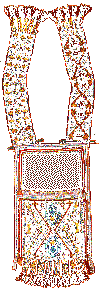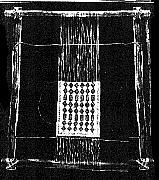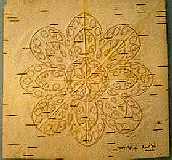Ojibwe Woven Beadwork Bandolier Bags
|
|---|
| Ojibwe of Canada made this red and grey-striped wool bandolier sometime in the late 19th century. The panel is loom-beaded, and so is the strap. |
 |
| This bag is from the Royal Ontario Museum's digital collection of craft objects. The asymmetry of the strap left and right designs is done here by using a more yellowish gold for background beads of the right strap. |
|
|---|
 |
This undated Ojibwe bag is fully woven in a pattern that reminded Earl Nyholm (who chose it for his essay in the NMAI book All Roads Are Good) of geese. No one can really know what the maker's pattern meant, though If you look at the details you can see what it means to you. This bag, was probably never worn. The top parts of the strap are not joined, and the cloth to join them is missing; the woven tabs may have been sewn on without closing the strap so it could have been worn. The two "sides" of what should be one strap are of different patterns, in keeping with the tradition "looks different, coming and going." Perhaps it was made to honor someone who died, and so left unfinished. |
|
|---|
| Ojibwe 1880 bandolier bag of moosehide, with red cloth and loom-beaded pouch and strap. Morningstar Gallery (of Santa Fe) wants $8,500 for it. The least impressive of the bandoliers, its strap has no differences in the left and right side patterns. |
 |
|
|---|
 |
An old loom or bead frame -- mazinaabidoo -- for wide weavings, for bandolier pocket panels and wide armbands or garters. The frame isn't rough, it's smoothed into a hexagon and has been smoked to shade-darken it. Beading is done with the loom at about a 45-degree angle. How loom beading is done is explained in Seed Beading Techniques |
|
|---|
 "An expert maker of woven work at Red Lake (Minnesota reservation) said that she never used a pattern, but had the design clearly in her mind before she started. The difficulty of this can be imagined when we consider she made a piece of work about 12 inches square for the pocket portion of the bead sacks, the pattern being a unit with corners and a border. She said she seldom made 2 alike. The pattern illustrated (Densmore copied it from a finishd bag) were said to be a conventional leaf with roses, and a simnilar pattren for the shoulder band. A majority of the patterns used in woven work are superior to those in applied work. Dream symbols are also more frequent in woven work." -- Frances Densmore, Chippewa Customs "An expert maker of woven work at Red Lake (Minnesota reservation) said that she never used a pattern, but had the design clearly in her mind before she started. The difficulty of this can be imagined when we consider she made a piece of work about 12 inches square for the pocket portion of the bead sacks, the pattern being a unit with corners and a border. She said she seldom made 2 alike. The pattern illustrated (Densmore copied it from a finishd bag) were said to be a conventional leaf with roses, and a simnilar pattren for the shoulder band. A majority of the patterns used in woven work are superior to those in applied work. Dream symbols are also more frequent in woven work." -- Frances Densmore, Chippewa Customs |
|
|---|
 Densmore said some makers of woven beadwork developed patterns using birchbark transparencies created by folding and biting the thin, flexible bark -- as shown. These are called mazinibaganjigan, designs made by biting. Making them and showing them by firelight was a favorite entertainment during long, dark winter evenings. Densmore said some makers of woven beadwork developed patterns using birchbark transparencies created by folding and biting the thin, flexible bark -- as shown. These are called mazinibaganjigan, designs made by biting. Making them and showing them by firelight was a favorite entertainment during long, dark winter evenings.
|
BANDOLIER Menu 
 CONTINUE -- Oldest bandoliers
CONTINUE -- Oldest bandoliers
Explanatory text and graphics copyright 1995, 1996.
CREDITS: The ROM bag is from the Royal Ontario Museum's digitial collection of Native craft, done under contract for Canada's SchoolNet. The second bag is a selection from the NMAI, photographed in All Roads Are Good for Earl Nyholm's essay. The third bag is from Morning Star, an Arizona Native arts and crafts commercial gallery. The loom was photographed by Densmore between 1910 and 1917. The birchbark biting is from the ROM's digital collection of Native craft objects.
Last Updated: Saturday, August 31, 1996 - 11:08:10 AM




 "An expert maker of woven work at Red Lake (Minnesota reservation) said that she never used a pattern, but had the design clearly in her mind before she started. The difficulty of this can be imagined when we consider she made a piece of work about 12 inches square for the pocket portion of the bead sacks, the pattern being a unit with corners and a border. She said she seldom made 2 alike. The pattern illustrated (Densmore copied it from a finishd bag) were said to be a conventional leaf with roses, and a simnilar pattren for the shoulder band. A majority of the patterns used in woven work are superior to those in applied work. Dream symbols are also more frequent in woven work." -- Frances Densmore, Chippewa Customs
"An expert maker of woven work at Red Lake (Minnesota reservation) said that she never used a pattern, but had the design clearly in her mind before she started. The difficulty of this can be imagined when we consider she made a piece of work about 12 inches square for the pocket portion of the bead sacks, the pattern being a unit with corners and a border. She said she seldom made 2 alike. The pattern illustrated (Densmore copied it from a finishd bag) were said to be a conventional leaf with roses, and a simnilar pattren for the shoulder band. A majority of the patterns used in woven work are superior to those in applied work. Dream symbols are also more frequent in woven work." -- Frances Densmore, Chippewa Customs Densmore said some makers of woven beadwork developed patterns using birchbark transparencies created by folding and biting the thin, flexible bark -- as shown. These are called mazinibaganjigan, designs made by biting. Making them and showing them by firelight was a favorite entertainment during long, dark winter evenings.
Densmore said some makers of woven beadwork developed patterns using birchbark transparencies created by folding and biting the thin, flexible bark -- as shown. These are called mazinibaganjigan, designs made by biting. Making them and showing them by firelight was a favorite entertainment during long, dark winter evenings.
